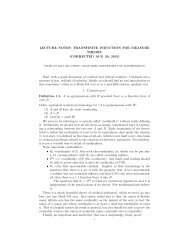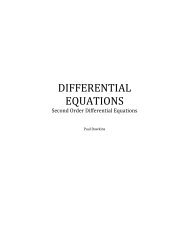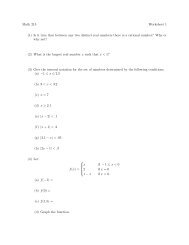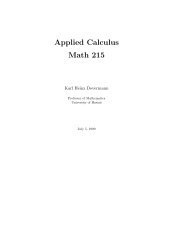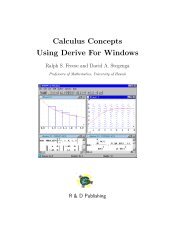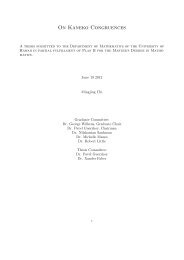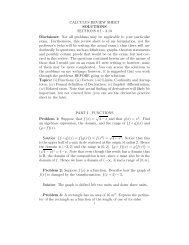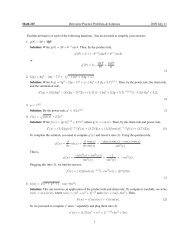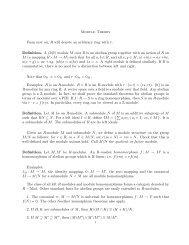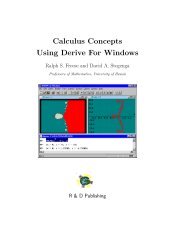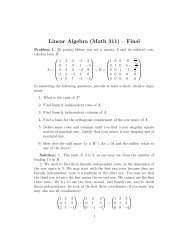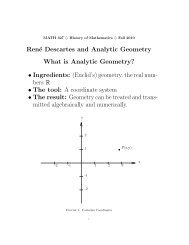Problems and Solutions in - Mathematics - University of Hawaii
Problems and Solutions in - Mathematics - University of Hawaii
Problems and Solutions in - Mathematics - University of Hawaii
Create successful ePaper yourself
Turn your PDF publications into a flip-book with our unique Google optimized e-Paper software.
1.1 1991 November 21 1 REAL ANALYSIS<br />
so this is what we will prove. The Radon-Nikodym theorem (A.12) says, if λ ≪ m are σ-f<strong>in</strong>ite positive measures<br />
on a σ-algebra Σ, then there is a unique g ∈ L1 (dm) such that<br />
<br />
λ(E) = g dm, ∀E ∈ Σ.<br />
E<br />
In the present case, µ ≪ µ + ν (s<strong>in</strong>ce the measures are positive), so the theorem provides an f ∈ L1 (µ + ν) such<br />
that<br />
<br />
µ(E) = f d(µ + ν) ∀ E ∈ Σ,<br />
E<br />
which proves (5). ⊓⊔<br />
9. 12 If f <strong>and</strong> g are <strong>in</strong>tegrable functions on (X, S, µ) <strong>and</strong> (Y, T , ν), respectively, <strong>and</strong> F (x, y) = f(x) g(y), show that<br />
F is <strong>in</strong>tegrable on X × Y <strong>and</strong> <br />
<br />
F d(µ × ν) = f dµ g dν.<br />
Solution: 13 To show F (x, y) = f(x)g(y) is <strong>in</strong>tegrable, an important (but <strong>of</strong>ten overlooked) first step is to prove<br />
that F (x, y) = f(x)g(y) is (S ⊗ T )-measurable. Def<strong>in</strong>e Ψ : X × Y → R × R by Ψ(x, y) = (f(x), g(y)), <strong>and</strong> let<br />
Φ : R × R → R be the cont<strong>in</strong>uous function Φ(s, t) = st. Then,<br />
F (x, y) = f(x)g(y) = (Φ ◦ Ψ)(x, y).<br />
Theorem A.2 states that a cont<strong>in</strong>uous function <strong>of</strong> a measurable function is measurable. Therefore, if we can show<br />
that Ψ(x, y) is an (S ⊗T )-measurable function from X ×Y <strong>in</strong>to R×R, then it will follow that F (x, y) is (S ⊗T )measurable.<br />
To show Ψ is measurable, let R be an open rectangle <strong>in</strong> R × R. Then R = A × B for some open sets<br />
A <strong>and</strong> B <strong>in</strong> R, <strong>and</strong><br />
Ψ −1 (R) = Ψ −1 (A × B)<br />
= {(x, y) : f(x) ∈ A, g(y) ∈ B}<br />
= {(x, y) : f(x) ∈ A} ∩ {(x, y) : g(y) ∈ B}<br />
= (f −1 (A) × Y ) ∩ (X × g −1 (B))<br />
= f −1 (A) × g −1 (B).<br />
Now, f −1 (A) ∈ S <strong>and</strong> g −1 (B) ∈ T , s<strong>in</strong>ce f <strong>and</strong> g are S- <strong>and</strong> T -measurable, resp. Therefore, Ψ −1 (R) ∈ S ⊗ T ,<br />
which proves the claim.<br />
Now that we know F (x, y) = f(x)g(y) is (S ⊗T )-measurable, we can apply part (b) <strong>of</strong> the Fub<strong>in</strong>i-Tonelli theorem<br />
(A.13) to prove that F (x, y) = f(x)g(y) is <strong>in</strong>tegrable if one <strong>of</strong> the iterated <strong>in</strong>tegrals <strong>of</strong> |F (x, y)| is f<strong>in</strong>ite. Indeed,<br />
<br />
<br />
|f(x)g(y)| dν(y) dµ(x) = |f(x)||g(y)| dν(y) dµ(x)<br />
X Y<br />
X<br />
<br />
Y<br />
<br />
<br />
= |f(x)| |g(y)| dν(y) dµ(x)<br />
X<br />
<br />
Y<br />
<br />
= |f(x)| dµ(x) |g(y)| dν(y) < ∞,<br />
12 See also: November ’97 (2), <strong>and</strong> others.<br />
13 I’m not sure if the claim is true unless the measure spaces are σ-f<strong>in</strong>ite, so I’ll assume all measure spaces σ-f<strong>in</strong>ite.<br />
In my op<strong>in</strong>ion, the most useful version <strong>of</strong> the Fub<strong>in</strong>i-Tonelli theorem is the one <strong>in</strong> Rud<strong>in</strong> [8], which assumes σ-f<strong>in</strong>ite measure spaces. There is a<br />
version appear<strong>in</strong>g <strong>in</strong> Royden [6] that does not require σ-f<strong>in</strong>iteness. Instead it beg<strong>in</strong>s with the assumption that f is <strong>in</strong>tegrable. To me, the theorem<br />
<strong>in</strong> Rud<strong>in</strong> is much easier to apply. All you need is a function that is measurable with respect to the product σ-algebra S ⊗ T , <strong>and</strong> from there, <strong>in</strong> a<br />
s<strong>in</strong>gle theorem, you get everyth<strong>in</strong>g you need to answer any <strong>of</strong> the st<strong>and</strong>ard questions about <strong>in</strong>tegration with respect to a product measure.<br />
8<br />
X<br />
Y




